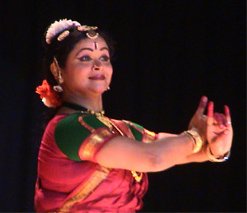
|
 |

|
 |
Our festive images and dolls - Padmaja Suresh, Bangalore e-mail: padmajasuresh@hotmail.com November 5, 2007  In India from the month of August starts a continuous period of festive celebrations throughout the country in every village, town, city, every nook and corner. During Krishna Janmashtami, some rock the adorable baby Krishna in cradles, sing lullabies and songs in his praise; some imitate his pranks (the Leelas) as the butter thief and climb atop one another to break pots of buttermilk, while some simply find ecstasy in singing and dancing his glory in bhajans with devotional outbursts. Ganesha is brought home amidst pomp and splendour. Every year, the sculptors kindle their creative spirits and bring out such amazingly lovely images of this most lovable Lord. Then when he gets immersed, it is a sad sight at our beaches and lakes to see the dilapidated pieces of the idols. Agreed that these pictures give a sad story on how a handsome, benevolent, revered GOD is brought down to this state. But that is the legend of Ganesha who took to form from dust and is significant of so many truths of life......even his exit after the festival! It only is a reflection of life cycle, birth to death and the fact that decay, disease and suffering are an unavoidable part of this cycle. The festive ritual of bringing home this idol, embellishing him, preparing his prasads, loving and worshipping him more than a member of our close family, thus bringing life into the idol just as a temple Tantri would do (of course any such worship has to be done in the proper manner to get positive effects) and then closing the chapter (every year) by immersing him, seems symbolic of man's coming into existence and going back to dust/soil. Our form is only the representation of the formless. Dolls play an important role in our lives. Be it during childhood, be it during adolescence or be it during later part of our life. We have all been making, collecting and using dolls to keep amused at play, to adorn homes with puppets or curios, to tell stories and more than anything, to offer our prayers symbolically as we do to our deities. The variety of dolls assembled aesthetically at Navratri includes not only deities but also human forms engaged in some activities or other like music, dancing, household chores or even games such as cricket. The various themes significantly represent the divinity in man and spread the message of love and unity, brotherhood and community development. The nine days signify worship for three days each for the three major Goddesses - Lakshmi Devi, Parvati Devi and Saraswati Devi each of them being bestowers of happiness, prosperity and learning. It symbolizes the importance given to Stree Shakti in our Puranas. The Energy - Prakriti that is embodied in the universal forms, unites with the Spirit-Purusha which remains as the universal Self. This great truth is represented when we place the human couple, generally made of wood, in the centre of the doll display. That we are ourselves comprised of the five elements is represented by the "Kalasha" containing water, mango leaves, fruits etc and lit brightly by a lamp just in front of it. Our prayers, our rituals, our customs, our symbols, our arts and cultural heritage do have meaning, beauty, significance and positive energy and effects, as long as they are followed, practiced and rendered with devotion and faith. The age old Mantra - Karagre vasate Lakshmi, Kara madhye Saraswati, Karamoole tu Givindaha, Prabhate Kara Darshanam - points out not only to the symbolic location of the Goddesses in one's palm but also indicates the possibility of one's possessing the entire cosmic energy of the combined Goddesses within the miniscule and infinitesimal palm, (perhaps the same principle is followed by Reiki practitioners). Hence, in temple worship, the various Mudras or hand gestures and in arts like Bharatanatyam, the Hastas bear divine semblance and significance other than just the beauteous appeal. Simple yet highly figurative and meaningful adornment and embellishment like the red colour application on hands and feet and other paraphernalia usually associated with the dancer's attire, all add up to the totality of experience. Accompanied by a supplication through music and dance, involving movement of face, limbs and other parts of the body, these gestures can bring one face to face with an image or idea worshipped. A degree of purity of oneself if maintained can be helpful to overcome diversions and distractions. Unless saturated with devotion, any Sadhana cannot kindle divine essence and spark with a mere automated, impersonal, soulless or perfunctory movement. Tapping and tuning in with the spirit and force would help channelise it just as one would get connected to a radio station with necessary tuning. Call him mystical, celestial or seraphic in nature, a true Yogi becomes 'hallowed' due to devoted practice. Coming back to our festivals, the celebrations are to be conducted with due regard to environment...just as we have to give regard to other issues like hospital's waste dumping, water purification, drainage etc. Care could be taken on the methods followed to make these idols with eco friendly substances and the cleanliness observed while immersion is very important. The significance has to be shared with our children so that the next generation would get involved in preserving and fostering our Indian heritage. Modern in outlook, yet traditional in roots is the best adage for the day. Bharatanatyam exponent, teacher and choreographer, Padmaja Suresh is a research scholar, Dept of Philosophy, Mysore University, Manasa Gangotri, Mysore. She is the Director of Kalpataru Kalavihar, Institute of Performing Arts, Bangalore. She is the daughter of late Chakyar Koothu Rajan, mono-act theater personality. |